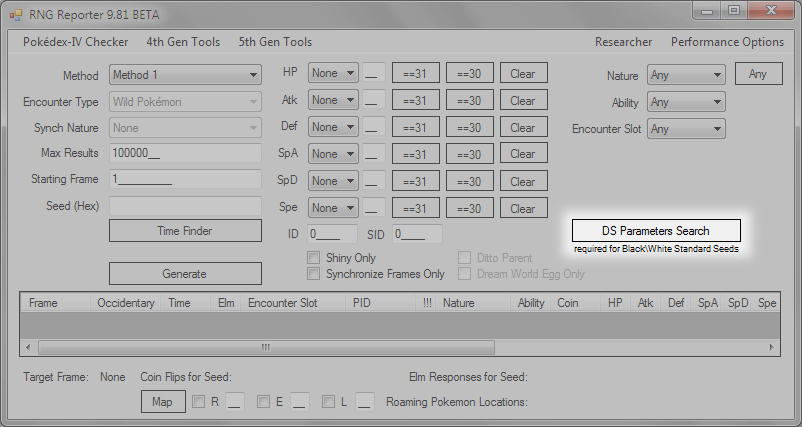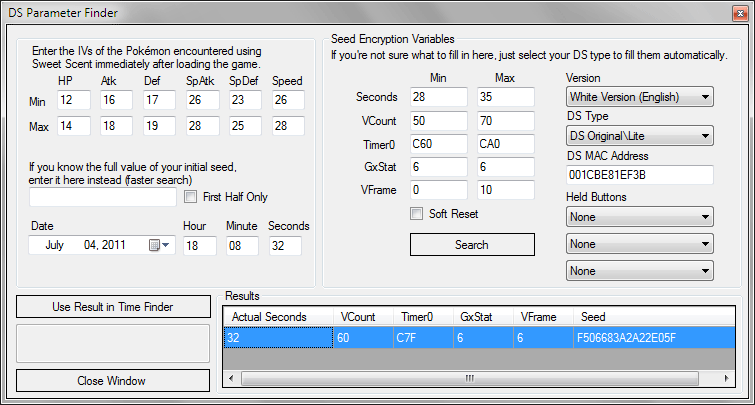BW RNG Manipulation Guide Part 1 - Common Information for Breeding, Capturing, and Receiving Perfect Pokemon
Before attempting to hatch or capture that perfect Pokemon, it will be useful to learn about some of the concepts that are common to both endeavors. The information in this section should be used to build up your knowledge and vocabulary so that the individual sections that follow will be clear and easy to follow.
- RNG Reporter
- Note to Mac Users: This software works under Windows and Linux. PPRNG is the Mac equivalent of the 5th Generation RNG Reporter. Use it instead.
- A clock with a clear Seconds reading
- Any kind of DS
- Pokemon Black or White
In the 4th Generation, all initial seeds are 32 bits long; however, in Black and White, they are twice as long, coming in at a grand total of 64 bits. All of the previous Methods in RNG Reporter are not useable in the 5th Generation for this reason.
When the game boots up, the upper half of the 64 bit initial seed is used to seed the Mersenne Twister RNG, which operates as a 32 bit look-up table. This table is used to generate the IVs for the Pokemon. We are able to re-seed this table by using the C-Gear; this will be covered later in this guide. This generation has no more relation of PID to IVs, meaning no IV combination is restricted from any nature / ability for any type of RNG.
One important change that we have is that the nature is no longer set by the PID that a Pokemon has; it is instead set at some other point in the RNG process when the Pokemon is generated by the game. Synchronization has no effect on the RNG, aside from changing the nature you would normally receive if the synchronization works.
These terms will be used frequently in the remainder of this guide, so it is very important that you understand what they mean.
- Initial Seed
- The initial seed is the number which is fed to the random number generator when the game starts. This number is created by a combination of the time and date the game started, your MAC Address, Keypress, and other Encryption Variables. Knowing the initial seed we start with allows us to predict the (no longer) random sequence of numbers that the game will produce and, in turn, how to proceed in order to catch the Pokemon or receive the Egg that we desire.
- It is important to know that the initial seed is no longer dependent on delay, which makes hitting initial seeds incredibly easy.
- Target Time
- When resetting for the IVs of Eggs or captured Pokemon, you must hard reset (power cycle) to hit your target time. In the following sections, target time is defined as the date and time of your DS upon booting the game. Please note that this has nothing to do with the "TIME" value that is shown on the "Continue" screen, as that indicates the amount of time that you have played the game and does not represent the current date and time on the DS clock.
- As opposed to the initial seeds in the 4th Generation, the initial seed in the 5th Generation is set once the game (re)boots; this makes it much easier to hit seeds as it only requires precision down to the second.
- C-Gear Seeds vs. Standard Seeds (Non C-Gear)
- This generation, a Mersenne Twister RNG is used to generate the IVs. In Generation 4, this same Mersenne Twister was used to create the Egg PIDs; however, this no longer is this the case in Generation 5. Standard seeds and C-Gear seeds determine the IVs of a Pokemon.
- Now to explain these two different seed types:
- Standard Seeds (Non C-Gear)
- These are the most commonly used seeds, and are very easy to hit. They are unique to your DS and game version. Unfortunately, they can be hit only at one time and date, so you are unable to choose the dates that appear on your Pokemon. The upper half is used to seed the MTRNG the moment the game (re)boots.
- C-Gear Seeds
- These seeds are commonly used for Entralink abuse. They are almost exactly the same as the seeds last generation except they also incorporate the MAC address of the DS.
- The seed is set the moment you turn on the C-Gear, or when you warp into the Entralink.
The main difference between the two seed types is that C-Gear seeds use delay in addition to date and time, while Standard seeds only require precision down to the target second. For the vast majority of this guide, the focus will be on Standard seeds.
- Delay
- The delay may be thought of as a fast counter that increases by one approximately 60 times per second. It starts when you launch (or soft reset) any of the Pokemon games. The delay is an important component of Entralink abuse, as a C-Gear seed must be used to hit your target IVs. Non C-Gear seeds do not use delay.
- An important change from the 4th Generation is that delays will never be consistently odd or even, as the games do not support Slot-2 Game Pak interaction.
- Frame
- A listing of frames is the sequence of Pokemon who can be captured or of IVs that may be passed down to an Egg, given a particular initial seed. A frame number, or target frame, is what you want to land on to get the desired result. There are different methods for targeting a particular frame, depending on what you are doing or where you are in game. For instance, when collecting an Egg, the frame will advance based on the amount of time that you spend before taking an Egg due to the onscreen or offscreen NPCs moving. When in a quiet cave, the frame does not advance at all on its own, but can be advanced by in-game actions, such as walking, saving, or listening to your awesome Chatot(s).
- Encounter Slot
- An encounter slot is a value that determines what Pokemon will appear depending on the frame on which you encounter a Wild Pokemon for the given encounter method.
Before beginning your quest for perfect IVs and shiny Pokemon, it is mandatory that you find the
Parameters for your DS and cartridge. These will vary from DS to DS, and the version of the game (in addition to language of the game). Collecting these Parameters will help you use Time Finder, a feature of RNG Reporter, in the most productive way possible.
Once you find your Parameters from Calibration, you can use it to hit spreads that you find in Time Finder without having to repeat the Calibration Phase.
Steps to Calibrate for RNG Abuse:
- Find the MAC Address of your DS

- Save your game in a location where you can easily and quickly catch a high level Pokemon, the best example is Kyurem.
- If you choose to catch a wild Pokemon instead of a stationary Pokemon, bring a Pokemon with the move Sweet Scent.
- Random NPCs have no affect on the process of finding your Parameters.
- A Wondercard gift cannot be used for finding your Parameters.
- Synchronize your DS clock with an external clock. Your external clock should have a seconds display or seconds hand. You do not necessarily have to synchronize the date of your DS to the actual date, but you need to know the date on your DS clock.
- Open up RNG Reporter and select DS Parameters.

- From the DS main menu, select your game exactly when the clock reaches the next minute. You will want to note the exact time you hard reset the game.
- Encounter a Pokemon as quickly as possible without moving any steps. This can be done with the move Sweet Scent, or by talking to the Stationary Legend you saved in front of.
- Catch the encountered Pokemon and find its IV range using an IV calculator such as MetalKid's.
- Using a Master Ball is fine. Once you are done Calibrating you can turn off your game without saving.
- Enter the date and time from Step 3 and the Pokemon's information from Step 5 into Parameters. Input the correct MAC address and range of Encryption Variables for your current DS and Version.
- Find your Parameters.

You will then be given the seed you hit, along with the Date and Time and your encryption variables. These encryption variables can be used in Time Finder to generate your spreads. Write down your Parameters somewhere safe, be it on your computer or on a sticky note.
There is no method of verifying this generation, aside from receiving your intended Pokemon. However, with the ease of hitting Standard seeds, this downside is negligible. NPCs and Shaking Spots will behave the same way if you hit the same seed and do the same actions.


